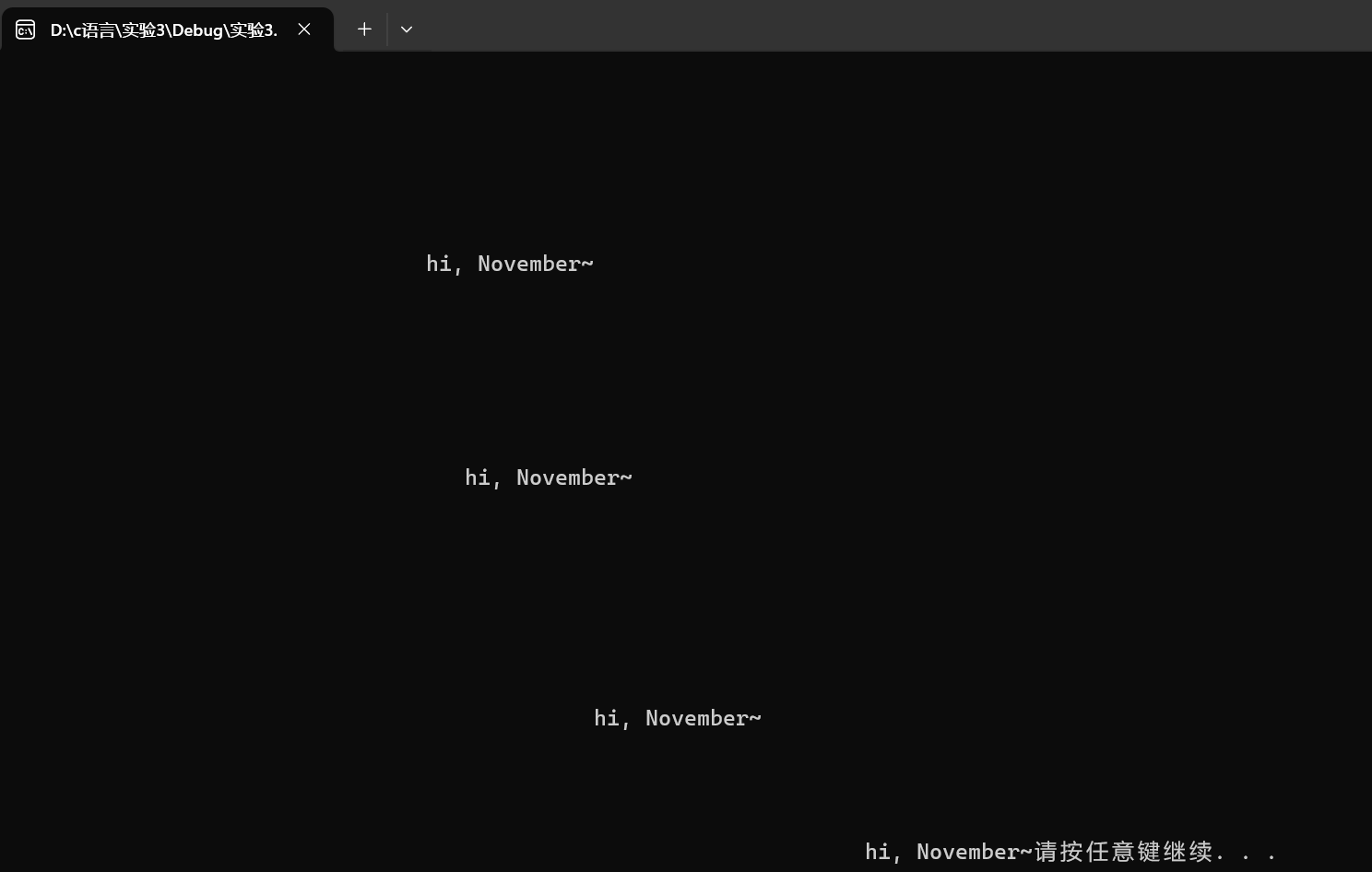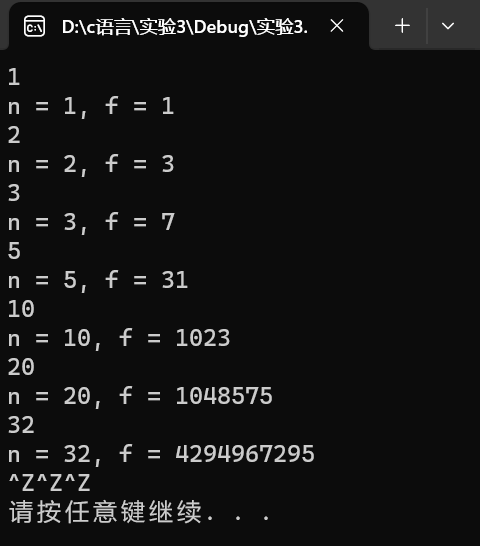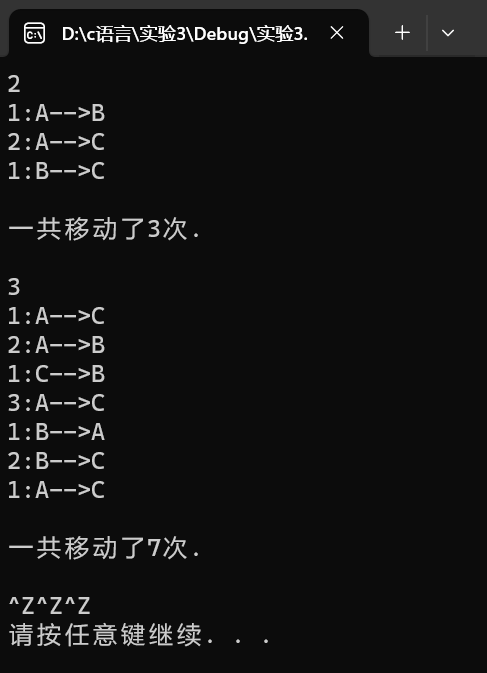实验3 C语言函数应用编程
1.实验任务1
task1源代码:
1 #include <stdlib.h> 2 #include <time.h> 3 #include <windows.h> 4 #define N 80 5 6 void print_text(int line, int col, char text[]); // 函数声明 7 void print_spaces(int n); // 函数声明 8 void print_blank_lines(int n); // 函数声明 9 10 int main() { 11 int line, col, i; 12 char text[N] = "hi, November~"; 13 14 srand(time(0)); // 以当前系统时间作为随机种子 15 16 for(i = 1; i <= 10; ++i) { 17 line = rand() % 25; 18 col = rand() % 80; 19 print_text(line, col, text); 20 Sleep(1000); // 暂停1000ms 21 } 22 system("pause"); 23 return 0; 24 } 25 26 // 打印n个空格 27 void print_spaces(int n) { 28 int i; 29 30 for(i = 1; i <= n; ++i) 31 printf(" "); 32 } 33 34 // 打印n行空白行 35 void print_blank_lines(int n) { 36 int i; 37 38 for(i = 1; i <= n; ++i) 39 printf("\n"); 40 } 41 42 // 在第line行第col列打印一段文本 43 void print_text(int line, int col, char text[]) { 44 print_blank_lines(line-1); // 打印(line-1)行空行 45 print_spaces(col-1); // 打印(col-1)列空格 46 printf("%s", text); // 在第line行、col列输出text中字符串 47 }
task1运行截图:

功能:随机空行/列打印“hi,november”,并停顿1秒,产生动画效果。
2.实验任务2
task2_1源代码:
1 // 利用局部static变量的特性,计算阶乘 2 3 #include <stdio.h> 4 #include <stdlib.h> 5 long long fac(int n); // 函数声明 6 7 int main() { 8 int i, n; 9 10 printf("Enter n: "); 11 scanf("%d", &n); 12 13 for (i = 1; i <= n; ++i) 14 printf("%d! = %lld\n", i, fac(i)); 15 16 system("pause"); 17 return 0; 18 } 19 20 // 函数定义 21 long long fac(int n) { 22 static long long p = 1; 23 24 p = p * n; 25 26 return p; 27 }
task2_1运行截图:

在25行添加【printf("p=%lld\n",p);】,运行截图:

task2_2源代码:
1 // 练习:局部static变量特性 2 3 #include <stdio.h> 4 #include <stdlib.h> 5 int func(int, int); // 函数声明 6 7 int main() { 8 int k = 4, m = 1, p1, p2; 9 10 p1 = func(k, m); // 函数调用 11 p2 = func(k, m); // 函数调用 12 printf("%d, %d\n", p1, p2); 13 14 system("pause"); 15 return 0; 16 } 17 18 // 函数定义 19 int func(int a, int b) { 20 static int m = 0, i = 2; 21 22 i += m + 1; 23 m = i + a + b; 24 25 return m; 26 }
task2_2运行截图:

总结static变量特性:static静态局部变量,使变量的生命周期与程序生命周期相同,程序结束时才销毁。离开定义它的函数后不能使用,但再次调用定义它的函数时,又可以继续使用,而且保留了前次被调用后留下的值。
3.实验任务3
task3源代码:
1 #include <stdio.h> 2 #include <stdlib.h> 3 long long func(int n); // 函数声明 4 5 int main() { 6 int n; 7 long long f; 8 9 while (scanf("%d", &n) != EOF) { 10 f = func(n); // 函数调用 11 printf("n = %d, f = %lld\n", n, f); 12 } 13 system("pause"); 14 return 0; 15 } 16 17 // 函数定义 18 long long func(int n){ 19 long long m; 20 if(n>=2){ 21 m=(func(n-1)+1)*2-1; 22 } 23 else 24 m=1; 25 26 return m;}
task3运行代码:

4.实验任务4
task4_1源代码:
1 #include <stdio.h> 2 #include <stdlib.h> 3 int func(int n, int m); 4 5 int main() { 6 int n, m; 7 8 while(scanf("%d%d", &n, &m) != EOF) 9 printf("n = %d, m = %d, ans = %d\n", n, m, func(n, m)); 10 11 system("pause"); 12 return 0; 13 } 14 15 // 函数定义 16 int func(int n,int m){ 17 int i,s; 18 int a=1,b=1; 19 for(i=n;i>=(n-m+1);--i) 20 b=b*i; 21 for(i=1;i<=m;++i) 22 a=a*i; 23 s=b/a; 24 return s;}
task4_1运行截图:

task4_2源代码:
1 #include <stdio.h> 2 #include <stdlib.h> 3 int func(int n, int m); 4 5 int main() { 6 int n, m; 7 8 while(scanf("%d%d", &n, &m) != EOF) 9 printf("n = %d, m = %d, ans = %d\n", n, m, func(n, m)); 10 11 system("pause"); 12 return 0; 13 } 14 15 // 函数定义 16 int func(int n,int m){ 17 int s; 18 if(m==n) 19 s=1; 20 else if(m>n) 21 s=0; 22 else if(m==0) 23 s=1; 24 else if(m==1) 25 s=n; 26 else 27 s=func(n-1,m)+func(n-1,m-1); 28 return s;}
task4_2运行截图:

5.实验任务5
task5源代码:
1 #include <stdio.h> 2 #include <stdlib.h> 3 void hanoi(unsigned int n,char from,char temp,char to);//函数声明 4 void moveplate(unsigned int n,char from,char to);//移动函数声明 5 6 int i=0; 7 int main(){ 8 unsigned int n; 9 while(scanf("%u",&n)!= EOF){ 10 hanoi(n,'A','B','C'); 11 printf("\n"); 12 printf("一共移动了%d次.\n",i); 13 printf("\n"); 14 i=0; 15 } 16 system("pause"); 17 return 0; 18 } 19 void hanoi(unsigned int n,char from,char temp,char to) 20 { 21 if(n==1) 22 moveplate(n,from,to); 23 else{ 24 hanoi(n-1,from,to,temp); 25 moveplate(n,from,to); 26 hanoi(n-1,temp,from,to); 27 } 28 } 29 30 void moveplate(unsigned int n,char from,char to) 31 { 32 printf("%u:%c-->%c\n",n,from,to); 33 ++i; 34 }
task5运行截图:

6.实验任务6
task6源代码:
1 long func(long s);//函数声明 2 3 int main() 4 { 5 long s,t; 6 7 printf("Enter a number:"); 8 while (scanf("%ld",&s)!=EOF){ 9 t=func(s); 10 printf("new number is:%ld\n\n",t); 11 printf("Enter a number:"); 12 } 13 system("pause"); 14 return 0; 15 } 16 17 long func(long s) 18 { 19 int a,b; 20 int i=1,c=0; 21 do 22 { 23 a=s%10; 24 s=s/10; 25 b=a%2; 26 if(b!=0) 27 { 28 c=a*i+c; 29 i*=10; 30 } 31 }while(s>=1); 32 33 return c; 34 }
task6运行截图:

7.实验任务7
task7源代码:
1 #include <stdio.h> 2 #include <stdlib.h> 3 4 int main() 5 { 6 //从47开始,平方、立方才能用到10个数字 7 int t,a,b,c,d,e,m,n,p,q,z; 8 for(t=47;t<100;++t) 9 { 10 b=t*t*t; 11 m=b%10; 12 b=b/10; 13 n=b%10; 14 if(m!=n){ 15 b=b/10; 16 p=b%10; 17 if(p!=n&&p!=m){ 18 b=b/10; 19 q=b%10; 20 if(q!=m&&q!=n&&q!=p){ 21 b=b/10; 22 z=b%10; 23 if(z!=m&&z!=n&&z!=p&&z!=q){ 24 b=b/10; 25 if(b!=m&&b!=n&&b!=p&&b!=q&&b!=z){ 26 a=t*t; 27 c=a%10; 28 a=a/10; 29 d=a%10; 30 if(c!=d&&c!=m&&c!=n&&c!=p&&c!=q&&c!=z&&c!=b){ 31 a=a/10; 32 e=a%10; 33 if(e!=c&&e!=d&&e!=d&&e!=m&&e!=n&&e!=p&&e!=q&&e!=z&&e!=b){ 34 a=a/10; 35 if(a!=c&&a!=d&&a!=e&&a!=m&&a!=n&&a!=p&&a!=q&&a!=z&&a!=b){ 36 printf("找到数字%d\n",t);}}}}}}}} 37 } 38 39 system("pause"); 40 return 0; 41 }
task7运行截图:

总结:歪瑞古德!




【推荐】国内首个AI IDE,深度理解中文开发场景,立即下载体验Trae
【推荐】编程新体验,更懂你的AI,立即体验豆包MarsCode编程助手
【推荐】抖音旗下AI助手豆包,你的智能百科全书,全免费不限次数
【推荐】轻量又高性能的 SSH 工具 IShell:AI 加持,快人一步
· 10年+ .NET Coder 心语 ── 封装的思维:从隐藏、稳定开始理解其本质意义
· 地球OL攻略 —— 某应届生求职总结
· 提示词工程——AI应用必不可少的技术
· Open-Sora 2.0 重磅开源!
· 周边上新:园子的第一款马克杯温暖上架